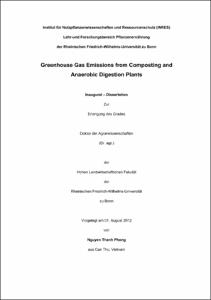Nguyen Thanh, Phong: Greenhouse Gas Emissions from Composting and Anaerobic Digestion Plants. - Bonn, 2012. - Dissertation, Rheinische Friedrich-Wilhelms-Universität Bonn.
Online-Ausgabe in bonndoc: https://nbn-resolving.org/urn:nbn:de:hbz:5n-30027
Online-Ausgabe in bonndoc: https://nbn-resolving.org/urn:nbn:de:hbz:5n-30027
@phdthesis{handle:20.500.11811/5130,
urn: https://nbn-resolving.org/urn:nbn:de:hbz:5n-30027,
author = {{Phong Nguyen Thanh}},
title = {Greenhouse Gas Emissions from Composting and Anaerobic Digestion Plants},
school = {Rheinische Friedrich-Wilhelms-Universität Bonn},
year = 2012,
month = oct,
note = {Almost all biowaste collected in Germany is treated either by composting or by anaerobic digestion (AD). Both treatments result in greenhouse gas emissions. The main focus of the thesis was to quantify the contribution of composting and anaerobic digestion plants to global warming. Data collection and measurements were performed at 9 composting plants and 9 AD plants treating biowaste. In the thesis, GHG emission factors were calculated in g per Mg fresh waste.
GHG emissions from composting plants were measured by using a tunnel method, which used a plastic tunnel covering a complete part of a windrow. The tunnel was ventiled by 2 vetilators. The concentration differences of GHG between incoming and outgoing air were used to calculate the emission from the waste under the tunnel. In average, composting resulted in 4060g (Mg biowaste)-1 CH4 emissions, 55g (Mg biowaste)-1 N2O emissions and 157g (Mg biowaste)-1 NH3 emissions, giving a total emission factor of 118kg CO2 equivalents (Mg biowaste)-1.
The emission sources at the AD consisted of biofilters, combined heat and power units (CHP), liquid digestate treatment systems (LTS) and open composting windrows of the solid digestate. In average, the biofilters removed 30% of total organic carbon (TOC), 50% of non methane volatile organic carbon (NMVOC) and 51% NH3, whereas N2O concentrations increased by 26%. For CH4 the biofilters had only a small removal effect (6%). Overall, the emission factors were reported as 1.2-16kg (Mg biowaste)-1 for CH4, 9-172g (Mg biowaste)-1 for N2O and 41-6,031g (Mg biowaste)-1 for NH3, giving total emission factors from 50 to 457 kg CO2 equivalents (Mg biowaste)-1. The post-treatment of solid digestate resulted in highest GHG emissions.
In order to reduce GHG emissions from composting windrows, small windrows with high turning frequencies and a short composting duration would result in the lowest emissions. For anaerobic digestion plants, potentially there are great GHG emissions benefits if biowaste is treated by wet anaerobic digestion. Wet digestion results in liquid digestate only, which should be directly applied without being composted.},
url = {https://hdl.handle.net/20.500.11811/5130}
}
urn: https://nbn-resolving.org/urn:nbn:de:hbz:5n-30027,
author = {{Phong Nguyen Thanh}},
title = {Greenhouse Gas Emissions from Composting and Anaerobic Digestion Plants},
school = {Rheinische Friedrich-Wilhelms-Universität Bonn},
year = 2012,
month = oct,
note = {Almost all biowaste collected in Germany is treated either by composting or by anaerobic digestion (AD). Both treatments result in greenhouse gas emissions. The main focus of the thesis was to quantify the contribution of composting and anaerobic digestion plants to global warming. Data collection and measurements were performed at 9 composting plants and 9 AD plants treating biowaste. In the thesis, GHG emission factors were calculated in g per Mg fresh waste.
GHG emissions from composting plants were measured by using a tunnel method, which used a plastic tunnel covering a complete part of a windrow. The tunnel was ventiled by 2 vetilators. The concentration differences of GHG between incoming and outgoing air were used to calculate the emission from the waste under the tunnel. In average, composting resulted in 4060g (Mg biowaste)-1 CH4 emissions, 55g (Mg biowaste)-1 N2O emissions and 157g (Mg biowaste)-1 NH3 emissions, giving a total emission factor of 118kg CO2 equivalents (Mg biowaste)-1.
The emission sources at the AD consisted of biofilters, combined heat and power units (CHP), liquid digestate treatment systems (LTS) and open composting windrows of the solid digestate. In average, the biofilters removed 30% of total organic carbon (TOC), 50% of non methane volatile organic carbon (NMVOC) and 51% NH3, whereas N2O concentrations increased by 26%. For CH4 the biofilters had only a small removal effect (6%). Overall, the emission factors were reported as 1.2-16kg (Mg biowaste)-1 for CH4, 9-172g (Mg biowaste)-1 for N2O and 41-6,031g (Mg biowaste)-1 for NH3, giving total emission factors from 50 to 457 kg CO2 equivalents (Mg biowaste)-1. The post-treatment of solid digestate resulted in highest GHG emissions.
In order to reduce GHG emissions from composting windrows, small windrows with high turning frequencies and a short composting duration would result in the lowest emissions. For anaerobic digestion plants, potentially there are great GHG emissions benefits if biowaste is treated by wet anaerobic digestion. Wet digestion results in liquid digestate only, which should be directly applied without being composted.},
url = {https://hdl.handle.net/20.500.11811/5130}
}






